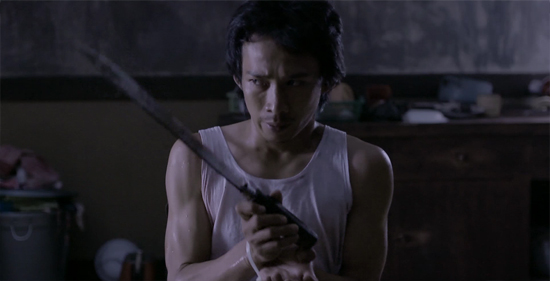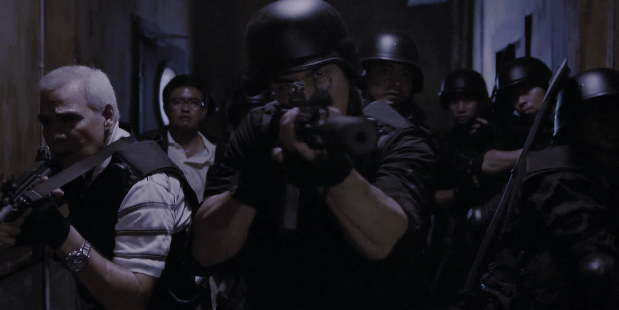
Written and Directed by Gareth Evans
Indonesia, 2011, imdb
For the martial arts aficianados out there, don’t even bother reading this review, just go to the theatre now. The Raid: Redemption is everything that you have heard it is and more. Offering a rare glimpse of the Indonesian martial art style Pentjak Silat, the film is one long, almost continuous combat sequence, with all the fights performed at mach speed by a stunt team that make Tony Jaa’s unit look like conservative wimps. Many of the fights are done with one or both fighters holding knives, but if anything they fight faster with knives than with empty hands.
Don’t ask, just go.
*****
OK. Everyone else, let’s talk about Roger Ebert, who has eviscerated this film not once, but twice, first giving it one star and then expanding his original review in a blog post to give more context to his dislike the film.
There’s obviously an audience for the film, probably a large one. They are content, even eager, to sit in a theater and watch one action figure after another pound and blast one another to death. They require no dialogue, no plot, no characters, no humanity. Have you noticed how cats and dogs will look at a TV screen on which there are things jumping around? It is to that level of the brain’s reptilian complex that the film appeals.
–Roger Ebert
It would be easy to dismiss Ebert’s criticisms on the grounds that complaining about the plot in a martial arts film is somewhat analogous to complaining about the plot of a porno. Except I am exactly the guy who would complain about the plot in a porno. In addition to that, I have been reading Roger Ebert’s reviews all my life. (He started writing for the Chicago Sun Times the year that I was born.) I respect his writing and I respect him so much that I have to take his criticism seriously.
There is no question that the set-up to The Raid: Redemption is simple to the point of being elliptical. It opens with Rama (Evans’ incredible star/choreographer Iko Uwais) waking in the pre-dawn and moving through a practiced routine: breakfast, prayer, and a furious martial arts work-out. He says good-bye to his very pregnant wife and then to his father, before going to work as a SWAT officer.
Rama is new to his unit and his rookie assignment is daunting: his 20 man unit are being asked to assault a high-rise apartment building run by a criminal overlord who rents the apartments to drug dealers, criminals on the run and the desperate poor who can’t afford to live anywhere else. The crime boss lives on the top floor, the 15th, so the team has to go through the entire building to arrest him. They make it to the 6th floor before a child look-out spots them, raises the alarm, and all hell breaks loose.
“The Raid” is monotonously single-tracked in showing one gruesome scene of hand-to-hand combat after another. Heads are destroyed like targets in a carnival sideshow booth. Bones are crunched as if Army Rangers are building a campfire. The corpses piling up in great numbers are disposed of, apparently, by invisible clean-up crews. Why are there no shots of the living stepping with difficulty over the bleeding mounds of the dead?
–Roger Ebert
(There is, in fact, a short lull in the film when Rama looks out the window and watches some of the building’s denizens dragging his dead team members into a pile in the middle of an alley behind the building.)
In its structure, The Raid: Redemption is very similar to Aliens. A group of soldiers assemble for a mission. They joke about the odds stacked against them, confident that their professionalism will overcome all the obstacles in their way. Only when they encounter the enemy do they realize how much danger they are in. And from that point on, they quickly find themselves the hunted rather the hunters. There is even a harrowing sequence when Rama finds himself trapped between the walls of the building, literally a drop of blood away from discovery and death.
The comparison is slightly to The Raid: Redemption‘s discredit, because one of Aliens‘ great achievements is giving a name and personality to so many of the marines about to become victims. Evans gets us to the action much faster, at the expense of having a greater emotional stake in the fate of Rama’s team. And when Cameron’s marines fall, their deaths are noted, if only on the TV monitors in the APC broadcasting their camera signals and vitals.
In the same way, The Raid: Redemption reminds one of Bruce Lee’s unfinished classic The Game of Death, but without Lee’s philosophical construction adding meaning to the various levels of the building or of Joe Cornish’s Attack the Block, but without that film’s tongue-in-cheek satire.
The key to understanding why the film works is a small moment early in the film. The SWAT team have just garotted the look-out and they sneak up on one of the building’s tenants, returning from a pharmacy with drugs for his sick wife. The paranoid SWAT team wants to put him on ice until Rama volunteers to look after the tenant so that he can get back to his sick wife.
Rama is the only man in the unit to show any respect for any occupant in the building. The rest treat anyone they meet as enemy combatants, at best to be restrained, at worst to be killed on sight. The man who ordered the attack on the building, Lieutenant Wahyu (Pierre Gruno), even shoots executes one of the kid lookouts on the 6th floor in a vain attempt to prevent the alarm.
When all hell breaks loose, it is the tenant who provides temporary shelter for Rama and the wounded Bowo (Tegar Satrya). While he takes them in, the tenant criticizes the raid as a pointless exercise, a fight between two forces equally corrupt. Rama protests, “Not all cops are corrupt.” The tenant responds, “If I thought that, I never would have opened the door,” suggesting with a sardonic expression that only Rama is dumb enough to swim upstream.
The problem with Rama’s universe is that the tenant is right. Their Indonesia is profoundly undemocratic. Sure, they can vote, but what use is voting when the police are hired servants and criminals can act with impunity as long as they grease the right palms? When a SWAT raid isn’t an exercise in justice, but a cover for a shakedown, a power struggle between two equally corrupt sides? When human rights are an inconvenience and when life, liberty and the pursuit of happiness are luxuries afforded only to the rich?
(As a non-sequitur aside, the greatest danger to democracy arising from the 2008 economic meltdown isn’t what happened to the economy. It’s the fact that the financial elite rigged the game in their favour and deliberately sabotaged the financial interests of the “muppets” who were their clients. Worse, not one of these robber barons has been so much as arrested for turning the financial system into their own crooked casino.)
In Canada, instead of life, liberty and the pursuit of happiness, our constitution is founded on the principles of peace, order and good government. Rama lives in a country where he is guaranteed none of the three.
A great deal of fuss has been made of Ebert taking pointed notice of Rama praying early in the film. On one hand, the point is taken that an Indonesian being Muslim and praying is about as remarkable as a Boston Irishman owning a crucifix. On the other hand, filmmaking is about making choices – there are no accidental scenes. The quiet moments early in the film are supposed to inform us about Rama’s character before the volcano erupts. On the gripping hand, when peace, order and good government are not available in the external world, it only makes sense to search for them within oneself, to find peace, order and good government internally through an active spiritual life – through prayer. And that spiritual life is what grounds Rama and gives him the compassion that ultimately saves his life and Bowo’s.
Is there no appreciation for human dimension, meaning, and morality? … I can’t take this much longer. I can’t function like a butcher’s scale. … “The Raid: Redemption” is dead in the water. The butcher slams the raw slab on his scale and asks, “How many are you feeding?”
–Roger Ebert
Dead in the water? Indeed.
The Raid: Redemption‘s tenement is an aquarium filled with piranhas, driven mad by water polluted with bloody corruption. The problem with Ebert’s review is that he is appalled by the two teams of piranha ripping the flesh from each other’s bones for our amusement. Good. He should be appalled. But the film’s story is not just the human piranha and their bloody fight. It is the story of the corrupted water that surrounds them and fills them and drives them mad.
Michael Ryan






